Mac and Cheese
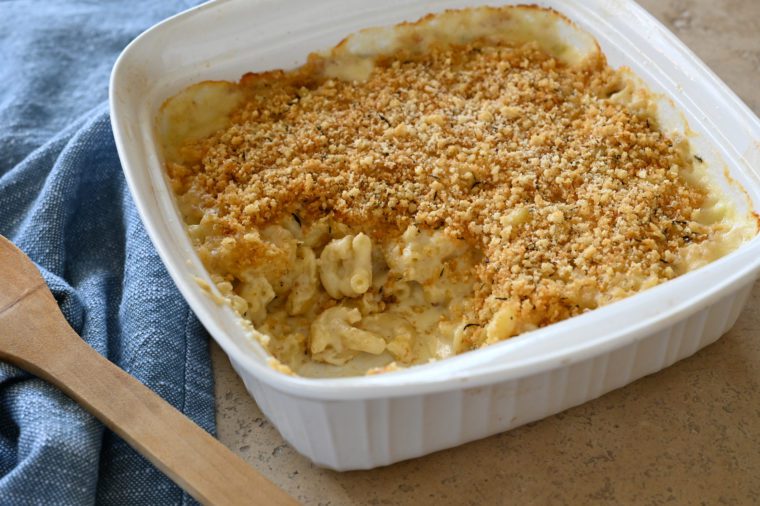
Good homemade baked mac and cheese begins with al dente noodles and a rich sauce made from butter, flour, milk, and loads of shredded cheese. The noodles are tossed with the cheesy sauce, transferred to a baking dish, topped with crispy breadcrumbs, and then baked until bubbling and golden. Since I find most homemade mac and cheese recipes to be a bit dry, I developed this version to be ultra-creamy. The crispy panko and herb topping is inspired by the delicious mac and cheese served at Maple Ave, a little gem of a restaurant near my hometown – it absolutely makes the dish! The recipe serves four as a main dish and six as a side; if you’d like to double it for a crowd, bake the mac and cheese in a 9×13-inch dish and increase the cooking time to 30 to 35 minutes.
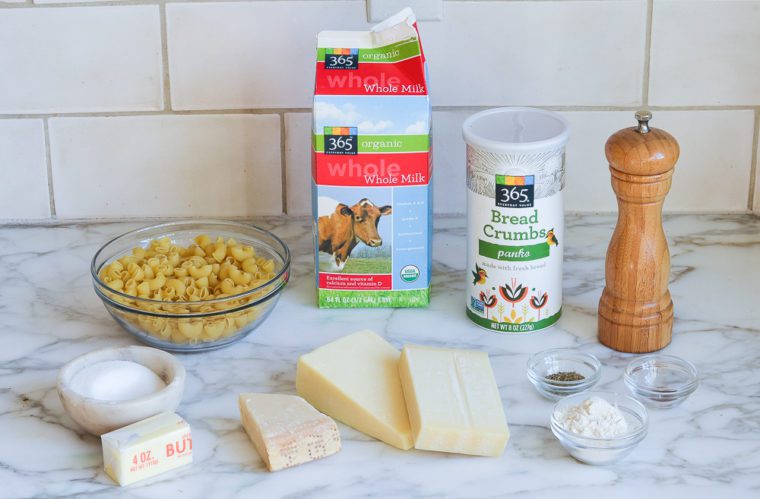 I use three different kinds of cheese in this recipe: Gruyère, extra-sharp Cheddar, and Parmigiano-Reggiano. Using more than one type of cheese adds dimension to the dish.
Be sure to use an authentic Swiss-made Gruyère that bears the AOP (Appellation d’Origine Protégée) seal, which shows that the cheese is made according to government-mandated quality standards. Similarly, it’s important to use authentic Parmigiano-Reggiano, which has a lot more flavor than domestic Parmesan. You can tell if it’s the real deal by the rind, which should be embossed with the name over and over. (If the cheese is already grated, it should be labeled “Parmigiano-Reggiano,” not “Parmesan.”)
I go the traditional route with the pasta and use elbow macaroni, but any pasta that has lots of nooks and crannies will work nicely.
I use three different kinds of cheese in this recipe: Gruyère, extra-sharp Cheddar, and Parmigiano-Reggiano. Using more than one type of cheese adds dimension to the dish.
Be sure to use an authentic Swiss-made Gruyère that bears the AOP (Appellation d’Origine Protégée) seal, which shows that the cheese is made according to government-mandated quality standards. Similarly, it’s important to use authentic Parmigiano-Reggiano, which has a lot more flavor than domestic Parmesan. You can tell if it’s the real deal by the rind, which should be embossed with the name over and over. (If the cheese is already grated, it should be labeled “Parmigiano-Reggiano,” not “Parmesan.”)
I go the traditional route with the pasta and use elbow macaroni, but any pasta that has lots of nooks and crannies will work nicely.
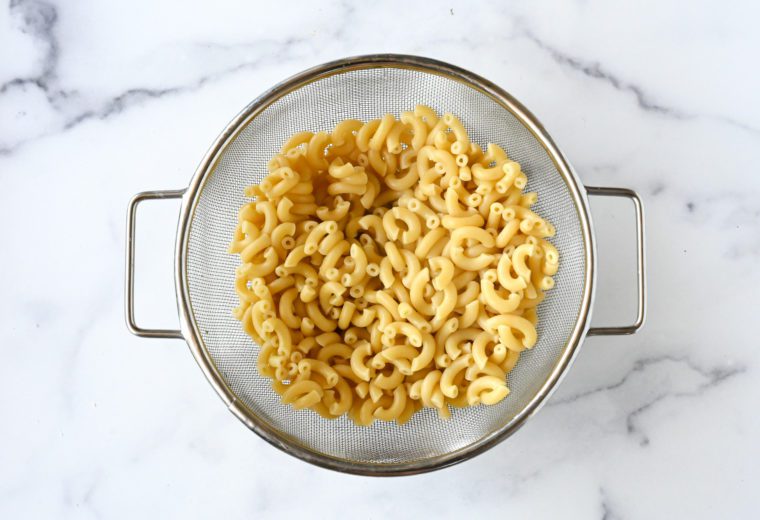
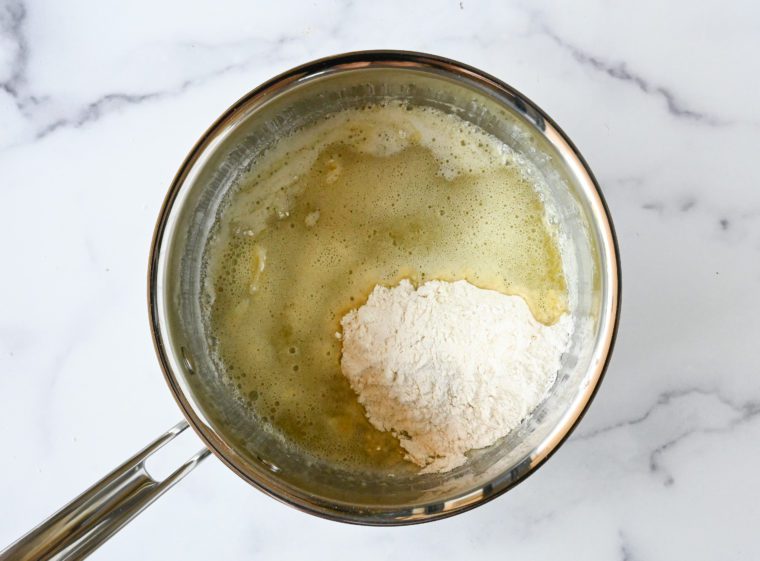 Stir with a whisk until the flour is combined. This mixture is called a roux.
Stir with a whisk until the flour is combined. This mixture is called a roux.
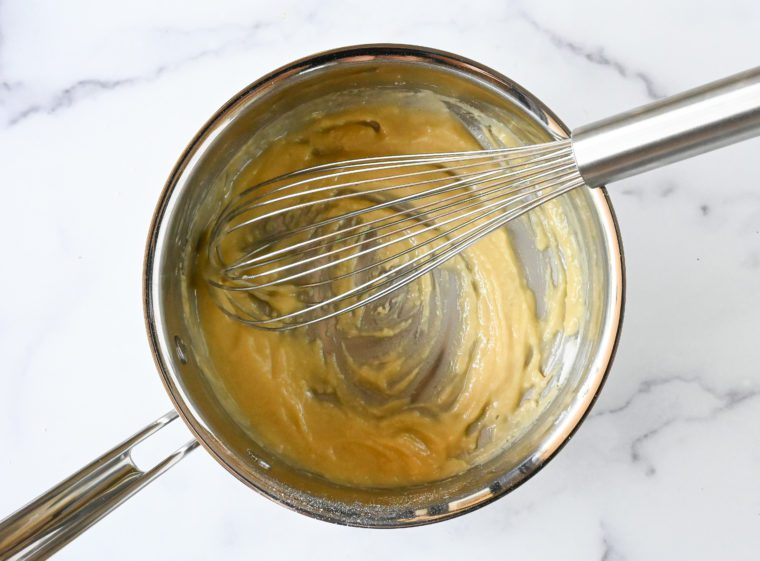 Continue cooking, whisking constantly, for 2 minutes. The roux will look foamy.
Continue cooking, whisking constantly, for 2 minutes. The roux will look foamy.
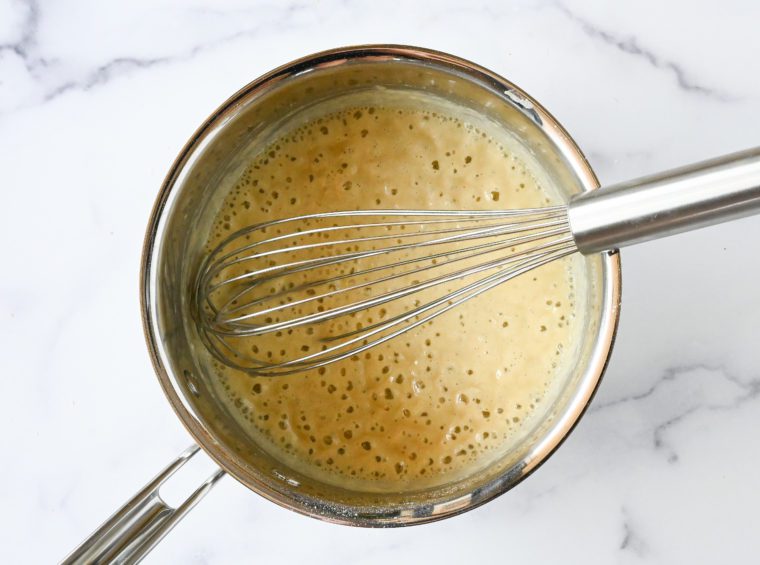 While whisking constantly, pour in the milk. Bring to a boil, then reduce the heat to low and cook for a few minutes more, until thickened and smooth. This French “mother sauce” is known as béchamel, or a sauce made from a white roux and milk.
While whisking constantly, pour in the milk. Bring to a boil, then reduce the heat to low and cook for a few minutes more, until thickened and smooth. This French “mother sauce” is known as béchamel, or a sauce made from a white roux and milk.
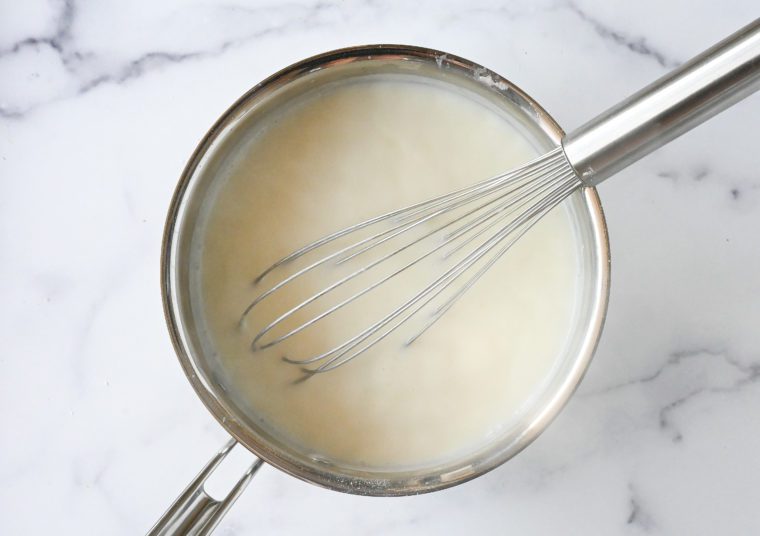 Off the heat, add the Gruyere, Cheddar, 1/4 cup Parmigiano-Reggiano, salt, pepper, and nutmeg.
Off the heat, add the Gruyere, Cheddar, 1/4 cup Parmigiano-Reggiano, salt, pepper, and nutmeg.
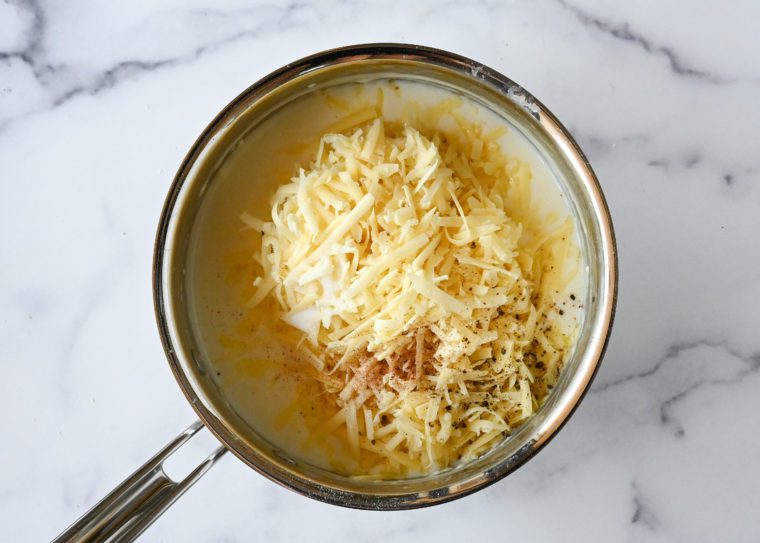 Whisk until the cheese is completely melted; if necessary, place the pan back over low heat but do not boil. The finished cheese sauce is known as Mornay sauce, or a béchamel sauce to which shredded or grated cheese is added.
Whisk until the cheese is completely melted; if necessary, place the pan back over low heat but do not boil. The finished cheese sauce is known as Mornay sauce, or a béchamel sauce to which shredded or grated cheese is added.
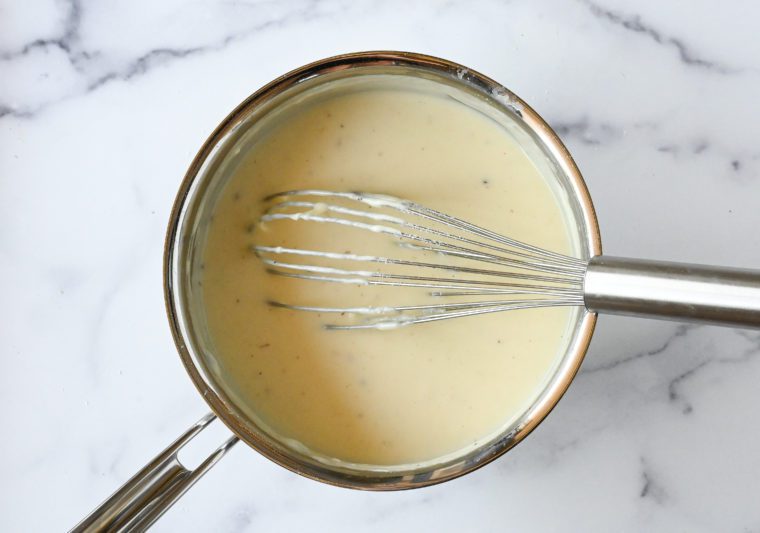
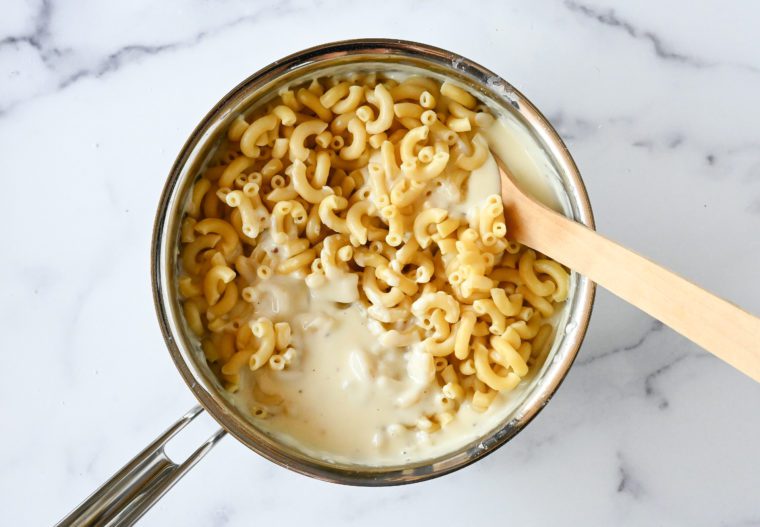 Stir to combine. It will seem way too soupy and creamy – that’s okay, that’s what you want!
Stir to combine. It will seem way too soupy and creamy – that’s okay, that’s what you want!
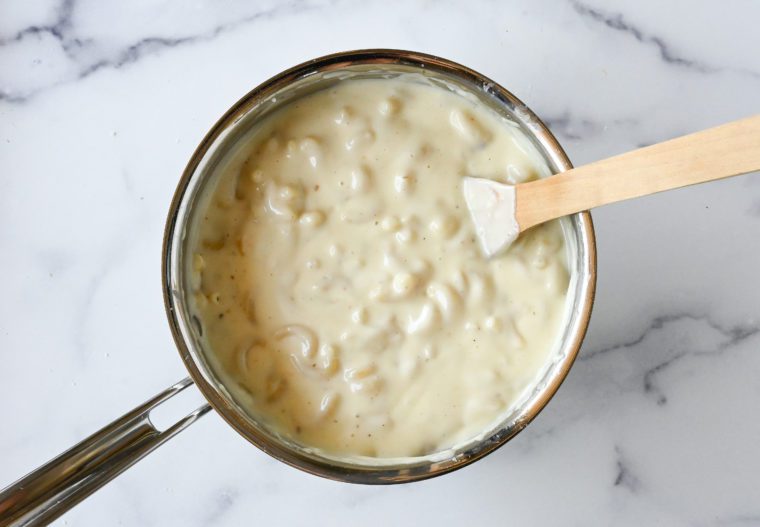 Pour into a buttered 2-quart baking dish and set aside.
Pour into a buttered 2-quart baking dish and set aside.
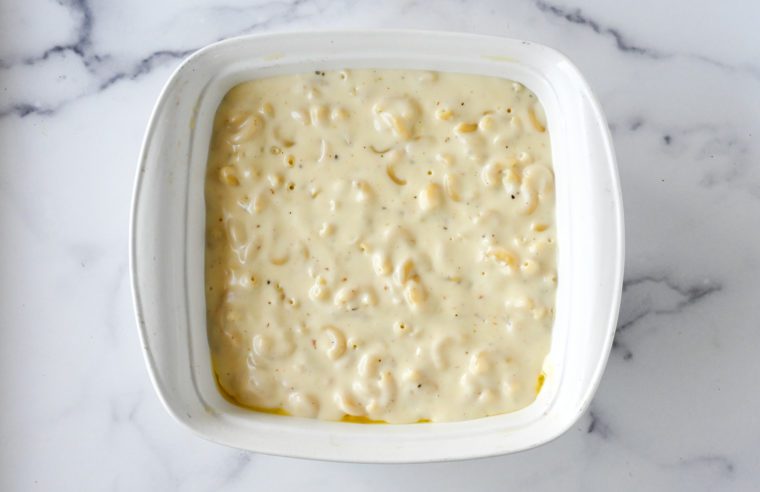
 Cook, stirring often, until golden brown, and then stir in the herbes de Provence or thyme. This step of browning the panko may seem unnecessary — you’d think it would brown in the oven — but I find it needs a head start on the stove to get really golden and crispy.
Cook, stirring often, until golden brown, and then stir in the herbes de Provence or thyme. This step of browning the panko may seem unnecessary — you’d think it would brown in the oven — but I find it needs a head start on the stove to get really golden and crispy.
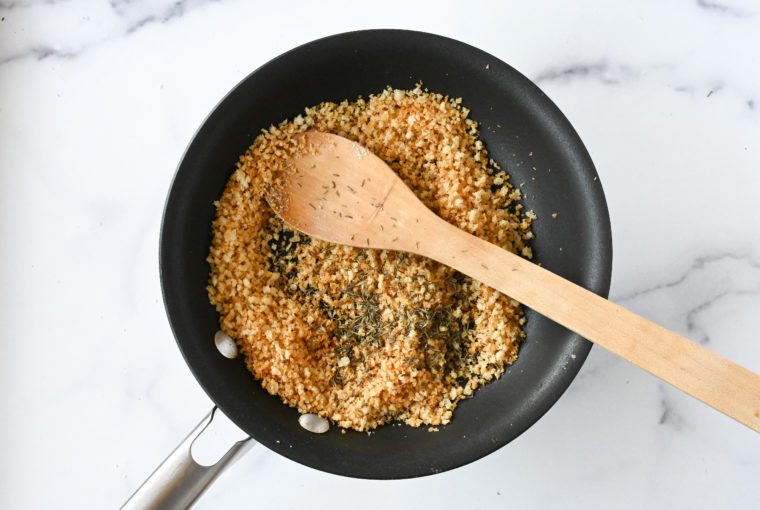
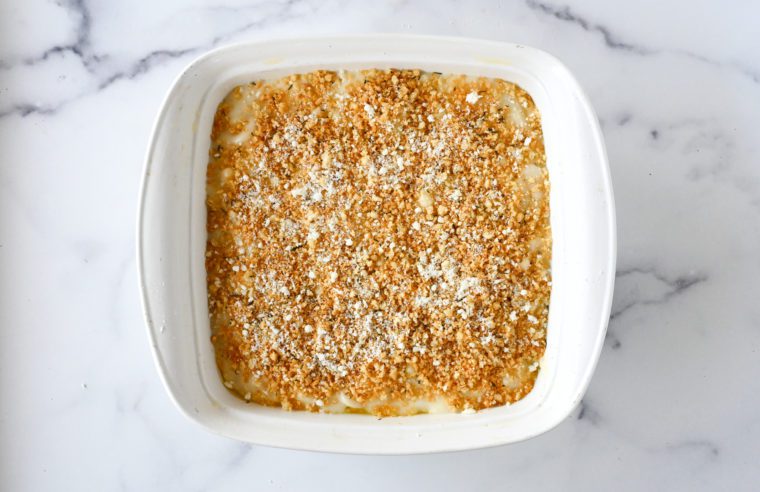 Bake for 25 to 30 minutes, or until bubbly and golden brown.
Bake for 25 to 30 minutes, or until bubbly and golden brown.
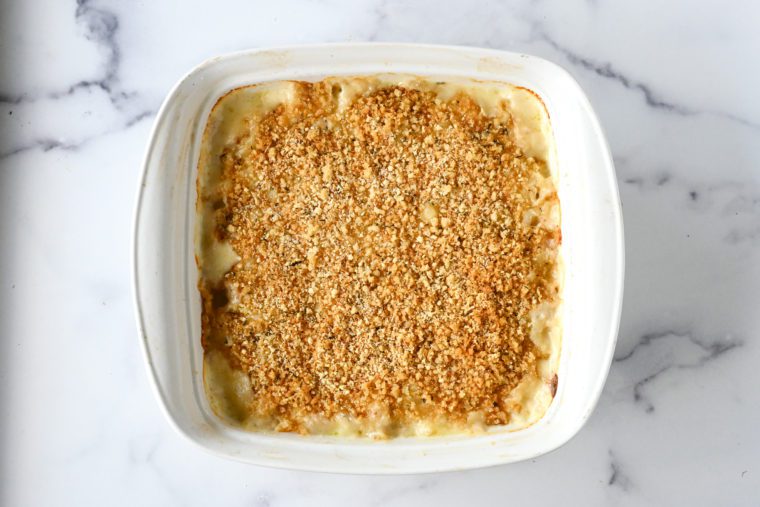 Serve warm out of the oven and enjoy. (Note: this recipe was originally posted on the blog in 2009 and updated in November of 2018. To download the original recipe, click here.)
Serve warm out of the oven and enjoy. (Note: this recipe was originally posted on the blog in 2009 and updated in November of 2018. To download the original recipe, click here.)
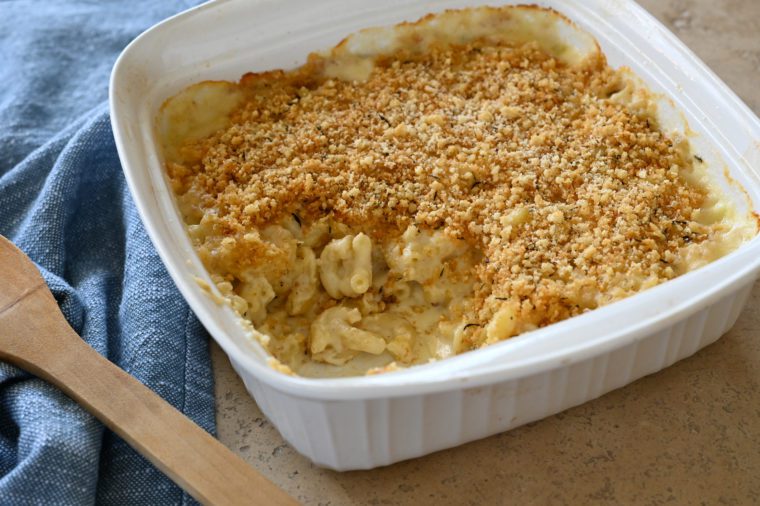 Please find original recipe here.
Please find original recipe here.
What you’ll need to make mac and cheese
 I use three different kinds of cheese in this recipe: Gruyère, extra-sharp Cheddar, and Parmigiano-Reggiano. Using more than one type of cheese adds dimension to the dish.
Be sure to use an authentic Swiss-made Gruyère that bears the AOP (Appellation d’Origine Protégée) seal, which shows that the cheese is made according to government-mandated quality standards. Similarly, it’s important to use authentic Parmigiano-Reggiano, which has a lot more flavor than domestic Parmesan. You can tell if it’s the real deal by the rind, which should be embossed with the name over and over. (If the cheese is already grated, it should be labeled “Parmigiano-Reggiano,” not “Parmesan.”)
I go the traditional route with the pasta and use elbow macaroni, but any pasta that has lots of nooks and crannies will work nicely.
I use three different kinds of cheese in this recipe: Gruyère, extra-sharp Cheddar, and Parmigiano-Reggiano. Using more than one type of cheese adds dimension to the dish.
Be sure to use an authentic Swiss-made Gruyère that bears the AOP (Appellation d’Origine Protégée) seal, which shows that the cheese is made according to government-mandated quality standards. Similarly, it’s important to use authentic Parmigiano-Reggiano, which has a lot more flavor than domestic Parmesan. You can tell if it’s the real deal by the rind, which should be embossed with the name over and over. (If the cheese is already grated, it should be labeled “Parmigiano-Reggiano,” not “Parmesan.”)
I go the traditional route with the pasta and use elbow macaroni, but any pasta that has lots of nooks and crannies will work nicely.
Step-by-Step Instructions
Step 1: Boil the Noodles
Bring a large pot of salted water to a boil. Add the pasta and cook until al dente, or just slightly underdone. (It will continue to cook in the oven so you don’t want it fully cooked.) Drain well and rinse with cold water.
Step 2: Make the Cheese Sauce
Meanwhile, melt 3 tablespoons of the butter in a medium (2-quart) pot over low heat and add the flour. Stir with a whisk until the flour is combined. This mixture is called a roux.
Stir with a whisk until the flour is combined. This mixture is called a roux.
 Continue cooking, whisking constantly, for 2 minutes. The roux will look foamy.
Continue cooking, whisking constantly, for 2 minutes. The roux will look foamy.
 While whisking constantly, pour in the milk. Bring to a boil, then reduce the heat to low and cook for a few minutes more, until thickened and smooth. This French “mother sauce” is known as béchamel, or a sauce made from a white roux and milk.
While whisking constantly, pour in the milk. Bring to a boil, then reduce the heat to low and cook for a few minutes more, until thickened and smooth. This French “mother sauce” is known as béchamel, or a sauce made from a white roux and milk.
 Off the heat, add the Gruyere, Cheddar, 1/4 cup Parmigiano-Reggiano, salt, pepper, and nutmeg.
Off the heat, add the Gruyere, Cheddar, 1/4 cup Parmigiano-Reggiano, salt, pepper, and nutmeg.
 Whisk until the cheese is completely melted; if necessary, place the pan back over low heat but do not boil. The finished cheese sauce is known as Mornay sauce, or a béchamel sauce to which shredded or grated cheese is added.
Whisk until the cheese is completely melted; if necessary, place the pan back over low heat but do not boil. The finished cheese sauce is known as Mornay sauce, or a béchamel sauce to which shredded or grated cheese is added.

Step 3: Combine the Noodles with the Sauce
Add the cooked pasta to the sauce. Stir to combine. It will seem way too soupy and creamy – that’s okay, that’s what you want!
Stir to combine. It will seem way too soupy and creamy – that’s okay, that’s what you want!
 Pour into a buttered 2-quart baking dish and set aside.
Pour into a buttered 2-quart baking dish and set aside.

Step 4: Prepare the Crispy Topping
In a small sauté pan over medium heat, melt the remaining tablespoon of butter and add the panko. Cook, stirring often, until golden brown, and then stir in the herbes de Provence or thyme. This step of browning the panko may seem unnecessary — you’d think it would brown in the oven — but I find it needs a head start on the stove to get really golden and crispy.
Cook, stirring often, until golden brown, and then stir in the herbes de Provence or thyme. This step of browning the panko may seem unnecessary — you’d think it would brown in the oven — but I find it needs a head start on the stove to get really golden and crispy.

Step 5: Bake
Sprinkle the toasted panko over the pasta and cheese sauce, followed by the remaining 2 tablespoons Parmigiano-Reggiano. Bake for 25 to 30 minutes, or until bubbly and golden brown.
Bake for 25 to 30 minutes, or until bubbly and golden brown.
 Serve warm out of the oven and enjoy. (Note: this recipe was originally posted on the blog in 2009 and updated in November of 2018. To download the original recipe, click here.)
Serve warm out of the oven and enjoy. (Note: this recipe was originally posted on the blog in 2009 and updated in November of 2018. To download the original recipe, click here.)
 Please find original recipe here.
Please find original recipe here.
Sampada Lohite
Hello Mayur, I have sent you a connection request. I would like to apply for Angular Team Lead. Thanks
Alex Parker
I would like to apply for ➝ Python UI Automation Engineer. Sent you invite. Thanks
Priya Singh
Thank you for this opportunity. I’m interested in the React Developer position.